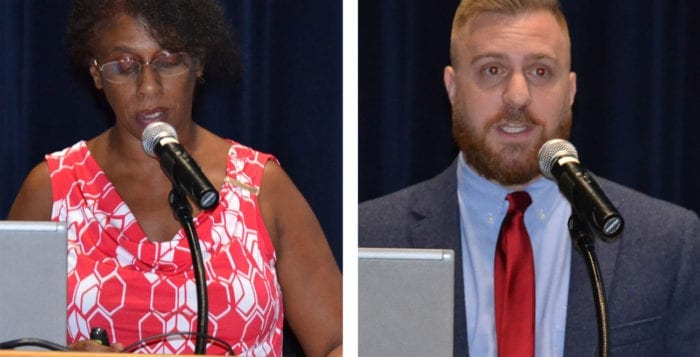Port Jefferson high school hosts educational forum on addiction

Port Jefferson high school played host to an educational forum on the ongoing addiction problem facing the community Oct. 19.
The forum, entitled The Adolescent Brain: Preventing High-Risk Behaviors, was presented by Bridge of Hope Resource Center, a Port Jefferson Station nonprofit created in 1998 with the goal of improving the lives of individuals in the community and is a strong advocate in the fight against addiction. Speakers featured a former Brookhaven National Lab scientist who specializes in addiction and the human brain, a doctor in the field of adolescent medicine at Stony Brook Children’s Hospital and the founder and president of the nonprofit.
Suffolk County has statistically been one of the greatest areas of concern in New York for heroin and opioid deaths in recent years, according to the Centers for Disease Control and Prevention. Suffolk County Police Commissioner Tim Sini said the county has had more than 100 opioid-related overdoses for several consecutive years.
The issue is not just in New York. According to the CDC, from 2005 to 2014, drug overdose deaths have risen by 144 percent to 2,300 deaths in New York and 58 percent to 47,055 deaths in the nation.
Dr. Joanne Fowler has studied how the human brain changes as a result of drug use since the late 1980s at stops including Brookhaven National Lab. She shared some of her decades of findings with those in attendance.
“When you think about addiction, it’s a really complex problem, and you have many, many factors that play into it,” she said. “Addiction, I would call, the loss of control of a behavior even though it’s causing a lot of problems to the individual. It’s a very destructive behavior that the individual can’t stop even though they want to stop.”
Fowler said the age in which an individual begins a behavior, like using drugs, can play a large roll in addiction because the part of the brain susceptible to addiction takes time to mature.
“The frontal cortex is a very important part of the brain,” she said. “It matures very slowly, so you really don’t have a mature frontal cortex until your early twenties.”
Dr. Zachary Jacobs, who works as a counselor for children at Stony Brook, discussed some risk factors for children and adolescents that could lead down a path of addiction, and some are out of a parent’s control.
“We’ve heard a lot about what parents and family can do, and I’m here to say despite your best efforts, it still might not be enough,” he said. “Despite a strong family, great, open communication, sometimes adolescents are just going to become their own individuals that disagree with family and societal norms … peers become so much more important than family, I’m sorry to say that.”
He recommended open communication and education as a means to combat potentially addictive, hazardous behaviors in children and adolescents to at least avoid issues with addiction, but total prevention is not that simple, he said.
Celina Wilson started Bridge of Hope Resource Center. She is the mother of three children, and she identified several risk factors parents should look for as potential signs of addiction. Insecurity pertaining to body image or loneliness, stress, life-changing events such as a divorce or death in the family, bullying, failure or rejection, depression, academic challenges, failure in competitive sports, a need for acceptance and several others were the factors Wilson suggested parents should be wary of and could be the root of later addiction.
“We have to help our teens better understand the world,” Wilson said. “We have to explain and review risks with them as much as possible.”






